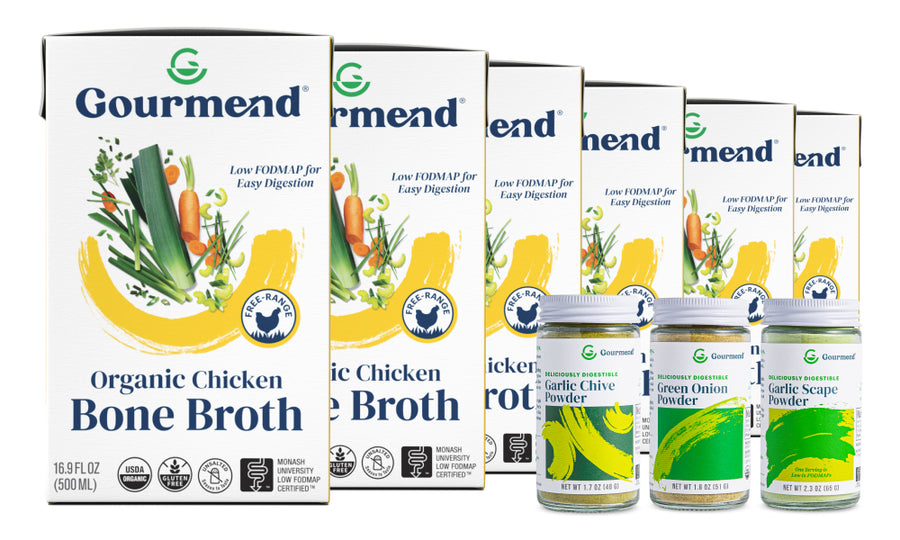Are Bell Peppers Low FODMAP? Science & Serving Guide

Key Takeaways
- Bell peppers are generally considered low FODMAP and can be included in a low FODMAP diet.
- Portion size is important, as larger amounts may trigger digestive discomfort.
- Choosing the right type and quantity of bell peppers can help maintain digestive comfort.
- Understanding individual tolerance is key when incorporating bell peppers into low FODMAP meals.
Table of Contents
- Understanding FODMAPs, What Does "Low FODMAP" Mean for Your Plate?
- The Color Code: Bell Pepper Varieties & Their FODMAP Content
- How Portion Size Impacts FODMAP Safety, And Why "More" Isn't Always Merrier
- Bell Peppers vs. Other Veggies, How Do They Stack Up for Low FODMAP Cooking?
- Real-World Kitchen Guide: Incorporating Bell Peppers into Low FODMAP Meals
Are Bell Peppers Low FODMAP? The Science, Serving Sizes & Smart Ways to Savor
If you're navigating the low FODMAP landscape, are bell peppers low FODMAP is likely a burning question, especially when you're craving that satisfying crunch and vibrant color in your meals. The short answer? Yes, but with important caveats that could make or break your digestive comfort.
At Gourmend Foods, we've helped thousands of customers master the art of flavorful, gut-friendly cooking. Bell peppers represent a perfect example of why portion precision matters more than simple "yes or no" lists when it comes to FODMAP safety.
For those starting out, having the right pantry staples can make all the difference. A Low FODMAP Pantry Starter Bundle ensures you have safe, delicious options on hand while you learn to navigate serving sizes and ingredient swaps.
| Color | Max Low FODMAP Serving | Primary FODMAP | Weight Reference |
|---|---|---|---|
| Green | 75g (⅔ cup chopped) | Fructans | ½ large pepper |
| Red | 43g (⅓ cup chopped) | Fructose | ¼ large pepper |
| Orange | 38g (¼ cup chopped) | Fructose | ¼ medium pepper |
| Yellow | 35g (¼ cup chopped) | Fructose | ¼ medium pepper |
These limits come from Monash University's rigorous FODMAP testing. Exceed them, and you risk triggering symptoms, not because bell peppers are inherently problematic, but because FODMAP load is cumulative. Mix a large red pepper with other moderate-FODMAP foods, and you've potentially stacked your way into digestive discomfort.
Understanding FODMAPs, What Does "Low FODMAP" Mean for Your Plate?
FODMAPs, fermentable oligosaccharides, disaccharides, monosaccharides, and polyols, are short-chain carbohydrates that some digestive systems struggle to absorb. When these compounds reach the large intestine undigested, gut bacteria ferment them rapidly, producing gas, bloating, and other IBS symptoms.
"Low FODMAP" doesn't mean zero FODMAPs. Instead, it refers to portions that contain less than the threshold amount likely to trigger symptoms in most sensitive individuals. Monash University established these thresholds through controlled feeding studies, measuring hydrogen breath levels to detect malabsorption.
Bell peppers matter because they're kitchen workhorses, appearing in everything from stir-fries to salads. Yet many online guides oversimplify their FODMAP status, leading to confusion. The reality: are bell peppers low FODMAP depends entirely on how much you eat and which color you choose. A green pepper offers more generous portions than its sweeter, riper cousins.
The Color Code: Bell Pepper Varieties & Their FODMAP Content

Comparing Red, Green, Yellow, and Orange Bell Peppers
Bell pepper FODMAP content shifts dramatically as peppers ripen. Green peppers are simply unripe versions of red, yellow, or orange varieties, harvested before sugars fully develop. This explains why green peppers taste more bitter and "grassy" while offering the most generous low FODMAP serving size at 75g.
As peppers ripen, natural sugars concentrate, particularly fructose. Red peppers develop the highest fructose levels, limiting safe portions to just 43g. Yellow peppers follow closely at 35g, while orange varieties fall in between at 38g. These aren't arbitrary restrictions, they're based on the specific fructose thresholds that trigger malabsorption in sensitive individuals.
For precise measuring, invest in a digital kitchen scale. Visual estimates fail consistently. A "small" red pepper might weigh 80g, nearly double the safe limit. When using mixed colors, measure each variety separately before combining, as their FODMAP loads don't average out safely.
How Portion Size Impacts FODMAP Safety, And Why "More" Isn't Always Merrier
FODMAP tolerance isn't binary, it's dose-dependent. Your digestive system might handle 35g of yellow bell pepper perfectly, but 50g could trigger bloating within hours. This cumulative effect explains why portion discipline matters more than ingredient elimination for long-term success.
Consider this scenario: You sauté 60g of red bell pepper (already over the 43g limit) with 30g of green beans and a tablespoon of Gourmend's garlic-chive oil. Individually, green beans are low FODMAP. Combined, you've potentially created a moderate FODMAP load that overwhelms your system's capacity.
Smart strategies include pre-portioning peppers during meal prep, storing measured amounts in labeled containers for grab-and-go convenience. Weigh peppers after washing and removing seeds, but before cooking, heat doesn't significantly alter FODMAP content, but accurate measurement prevents accidental overconsumption.
If you accidentally exceed safe portions, don't panic. Symptoms typically appear 2-6 hours post-consumption and resolve within 24-48 hours. Reduce FODMAP intake for the remainder of the day, stay hydrated, and consider gentle movement to support digestion. Track your response, some individuals tolerate slightly higher amounts, while others need stricter limits.
Visual cues help estimate portions when scales aren't available: 35g yellow pepper equals roughly one thin slice from a large pepper, while 75g green pepper resembles half of a medium bell pepper. However, peppers vary significantly in size and weight, making scales the most reliable measurement method.
Bell Peppers vs. Other Veggies, How Do They Stack Up for Low FODMAP Cooking?
Bell Peppers vs. High FODMAP Peppers & Vegetables
Bell peppers offer significant advantages over many popular vegetables that carry higher FODMAP risks. Unlike poblano peppers (high in polyols) or leek bulbs (loaded with fructans), bell peppers provide substantial serving sizes when portioned correctly. Shiitake mushrooms contain mannitol and must be avoided entirely in dried form, while fresh mushrooms require tiny portions, making bell peppers a more practical choice for those following a low FODMAP diet. If you're curious about other vegetables, are carrots low FODMAP and are potatoes low FODMAP are helpful reads for expanding your meal options.
For those seeking variety and convenience, a Low FODMAP Sampler Bundle can help you experiment with different flavors while staying within safe limits. And if you love bold flavors, try Low FODMAP Taco Seasoning to spice up your next pepper-packed meal.
Real-World Kitchen Guide: Incorporating Bell Peppers into Low FODMAP Meals

Measuring & Prepping for Precise Portions
Precision transforms peppers fodmap safety from guesswork into reliable meal planning. Start with these essential steps:
- Wash and de-seed peppers before weighing, seeds add negligible weight but removing them now prevents mess later.
- Weigh raw portions using a digital kitchen scale before combining with other ingredients.
- Label and separate different colored peppers if using multiple varieties, their FODMAP limits don't stack.
Meal-prep efficiency tip: Slice and weigh pepper portions into labeled freezer bags on Sunday. Write the color and gram amount on each bag. When Wednesday's dinner calls for red bell pepper, grab your pre-measured 43g portion without recalculating.
Avoid "portion creep" in one-pot dishes like stir-fries or sheet-pan meals where it's tempting to add "just a little more color." That extra handful can push you over safe FODMAP limits, especially with the more restrictive yellow and orange varieties.
Cooking Techniques for Maximum Flavor, Minus the FODMAPs
Roasting caramelizes bell peppers' natural sugars, creating deeper sweetness without adding FODMAPs. Toss measured portions with olive oil and roast at 425°F for 20-25 minutes until edges char slightly.
Grilling adds smoky complexity that elevates simple preparations. Cut peppers into wide strips to prevent small pieces from falling through grates. The char marks aren't just visual, they contribute genuine flavor depth.
Sautéing in garlic-chive oil provides the aromatic foundation that traditional recipes achieve with garlic bulbs. Heat olive oil with chopped garlic-chive stems, add measured bell pepper portions, and finish with a splash of Gourmend chicken broth for extra richness. For a finishing touch, sprinkle with Organic Garlic Chive Salt to enhance flavor without adding FODMAPs.
For additional guidance on FODMAP-friendly foods, you can review this comprehensive low FODMAP diet guide from the University of Virginia.
Frequently Asked Questions
Are all colors of bell peppers equally safe to eat on a low FODMAP diet?
Not all bell pepper colors are equally safe on a low FODMAP diet. Green bell peppers have a higher safe serving size compared to red, yellow, and orange varieties, which require smaller portions due to their higher fructose content as they ripen.
How do portion sizes of different bell pepper varieties affect their FODMAP content and digestive tolerance?
Portion size directly impacts the FODMAP load of bell peppers. Eating larger amounts, especially of red, yellow, and orange peppers, can increase fructose intake and may trigger digestive discomfort, while sticking to recommended serving sizes helps maintain digestive comfort.
Why do ripe bell peppers like red, yellow, and orange have lower safe serving sizes compared to green bell peppers?
Ripe bell peppers such as red, yellow, and orange contain more fructose than green peppers. This higher fructose level means their safe serving sizes are smaller to prevent exceeding low FODMAP thresholds and reduce the risk of digestive symptoms.
What strategies can I use to incorporate bell peppers into low FODMAP meals without triggering symptoms?
To enjoy bell peppers safely, choose the right color and stick to recommended portion sizes. Combine them with other low FODMAP ingredients to balance your meal, and pay attention to your individual tolerance as you gradually introduce peppers into your diet.





